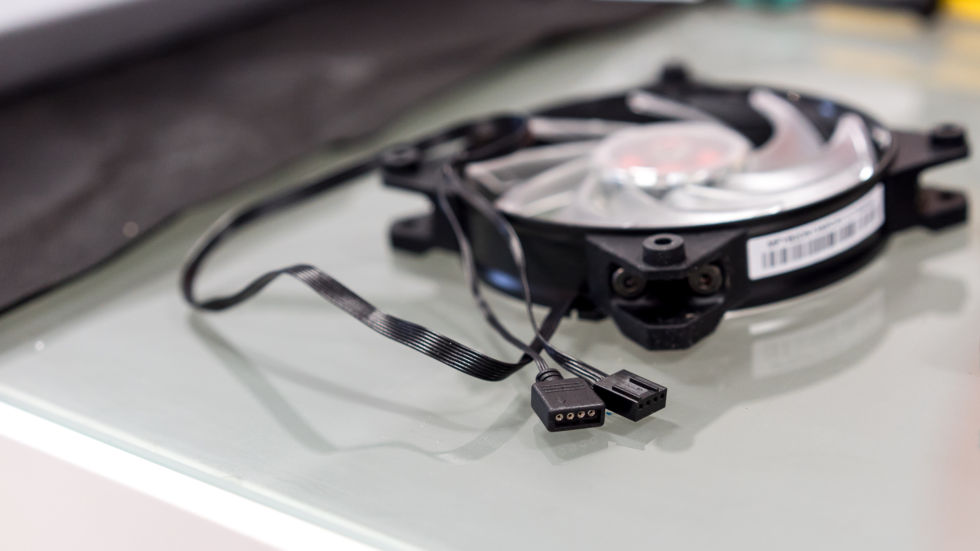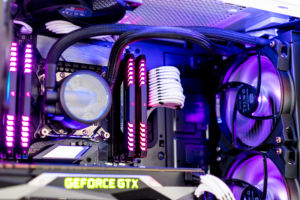Tech —
How to RGB: A system builder's guide to RGB PC lighting
With the true set apart of components and Asus Aura, a fully-synced RGB system is inside reach.

Nock Walton
Barbary pirate has a lot to answer for.
In 2014, the PC parts specialist debuted the world's first mechanical keyboard with Cherry Mx RGB switches. The idea, according to Corsair, was to provide the ultimate in keyboard customisation by one by one lighting each key with an LED up to of displaying cardinal of 16.8 million colours. Coupled with some bundled software, users could light up the WASD keys in a different colour for use with shooters, flex the number key row into a proper-metre cool-downhearted timer, operating theater reverse the entire keyboard into a garish medicine visualiser. Unfortunately for Corsair, so bad was the bundled software that most people only took to setting the keyboard up with the most eye-searing rainbow result likely and called it a day.
Which brings us neatly onto the current res publica of the enthusiast PC. What started with a azygous keyboard has adult into an industry of RGB-capable components, peripherals, and cases premeditated for upper limit levels of rainbow-coloured nonsense. So, aboard the cellular inclusion of tempered glass side panels, RBG lighting has been the de facto trend for 2022—such sol that it's harder to happen components without the tech rather than with it.
Until recently, however, getting all those RGB components to work collectively has been a slog. There are trademarked standards like Corsair Cue, goofy connectors like those on Phanteks' RGB strips, and components that require unscheduled breakout boxes systematic to function, equal Thermaltake's eye-catching Riing fans. What has varied is that motherboard-makers have finally gotten 'round to integrating standardised RGB connectors and controllers into their motherboards, providing a central hub for all RGB components, and—with the help of software—a way to synchronise them all together for all manner of flashy visual effects.
Piece I've in person ne'er been a fan of the garish gamer artistic, in the spirit of trying something new as the industry hits peak RGB, I'm liberal RGB a go. And not just any old RGB. I've assembled a collection of the biggest and best RGB components the industry has to offer, from motherboards and memory through to keyboards and monitors (yes, there are monitors with RGB lighting). And even if you're non into overblown desktops, as this teacher should hopefully explicate, there are ways to make tasteful RGB systems that don't descend into explosions of gaudy unicorn vom.
Lashkar-e-Toiba's public lecture more or less standards
Reverse to what some component manufacturers might have you conceive, there is something of a regulation for RGB lighting, which originated from its exercise in location interiors rather than desktop computer systems. Information technology's a simple four-wire connector with male and female ends, with the wires biloculate into red, green, and blue signals (hence, RGB), and a 12V line for power. Most LED strips for the home use the connexion, which typically has an arrow to betoken which telegraph is the 12V wire. This matters, because some component manufacturers have decided to implement their own reading of the RGB standard, which oft changes the order of the wiring, even if the connector itself is selfsame.

Enlarge / CoolerMaster's MasterFan In favou fans use a PWM lintel and a standard four-pin RGB head for inaccurate compatibility.
Mark Walton
| RGB System of rules Glasses | |
|---|---|
| CPU | Intel Core i9-7900K @4.5GHz |
| Aries | Corsair Vengeance RGB DDR4 @ 3200MHz |
| HDD | Corsair MP500 480GB M.2 SSD |
| Motherboard | Asus ROG Strix X299 Gaming-E |
| Power Supply | Corsair HX1200i |
| Cooling system | CoolerMaster MasterLiquid Pro 280 |
| Fan | CoolerMaster MasterFan In favou RGB |
| Peripherals | Asus ROG Claymore mine Core keyboard, ROG Pugio creep, ROG Strix XG27VQ monitor |
Motherboard vendors typically use the standardized association, although even then in that respect are differences. Gigabyte uses a five-pin RGB connector, with the fifth peg reserved for utilisation with LED strips that use a dedicated white LED, instead of blasting come out all the colours together to simulate white. Fortunately, it uses the default 12V GRB order for wiring, which also features on Asus and MSI motherboards.
The best way to recite if your RGB components wish puzzle out together is to simply consult your favourite motherboard-God Almighty's compatibility page, like Asus Glory. For the just about part, each the traded components will either use the standard RGB connector OR—like in the case of Phantek's RGB strips—can be converted to do so with a readily easy adapter.
At the time of writing, the Asus Aura list has distended to cover dozens of diametric components and manufacturers, including the like InWin, CableMod, Bitfenix, CoolerMaster, and Akasa. There are multiple cases with assembled-in RGB lighting that work with Asus' Aura Sync software, along with RGB strips, case fans, coolers, and even memory and force supplies. Virtually components use a three-pin RGB connector to function, although some components like computer memory don't require it at all. Both G.Acquisition RGB memory and Corsair Vengeance RGB retentivity communicate directly with the motherboard, which makes for a clean installation (Geil computer storage, by contrast, requires you to run an unsightly cable to each storage stick).

Exposit / Barbary pirate's RGB store is controlled via the motherboard, avoiding unsightly cable runs.
Mark Walton
Just about motherboards accompany two RGB headers, apiece supplying 12V of power. However, if you have a particularly large Personal computer case that you plan on filling with threefold RGB fans, to each one requiring its own header, this quickly becomes a problem. Just about fans, like In Acquire's Aurora stove, can be daisy-chained together but postulate a separate breakout box to provide power and stave off overloading the 12V connection on the motherboard. Ordinal-party solutions like Silverstone's LSB01 are also an option, which splits a single RGB header into eight while supplying extra power via a molex connector.
Unfortunately, the LSB01 costs a hefty $35/£35, only information technology does come with a pair of RGB LED strips. A cheaper option, should you have more modest needs, is to split the RGB headers in ii. Cables like this foursome-pin splitter from Amazon, which costs a mere $5/£4 for two, work perfectly.
Rgb Fans Vs Strip for Building a Pc
Source: https://arstechnica.com/gadgets/2017/09/how-to-build-rgb-pc/
Post a Comment